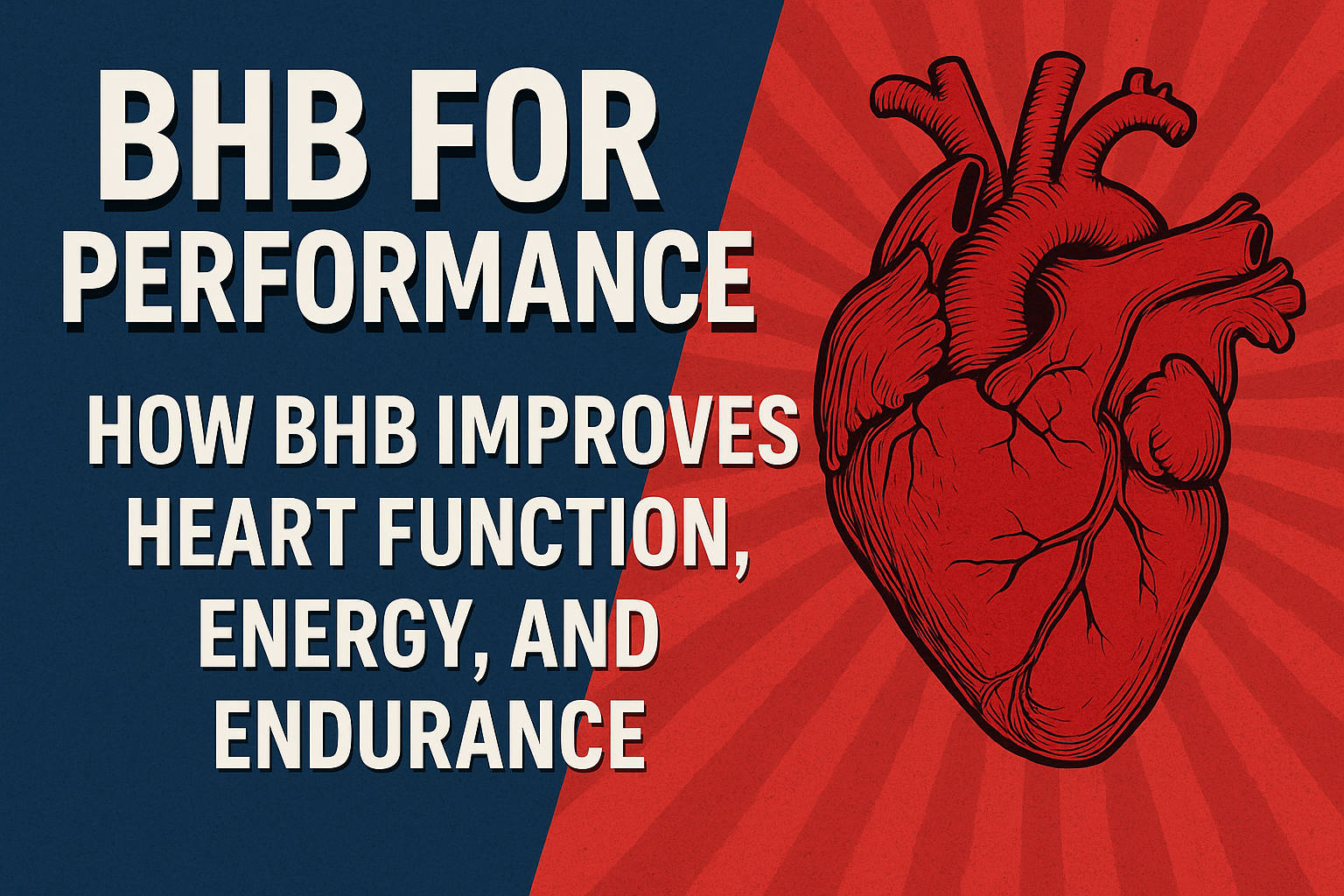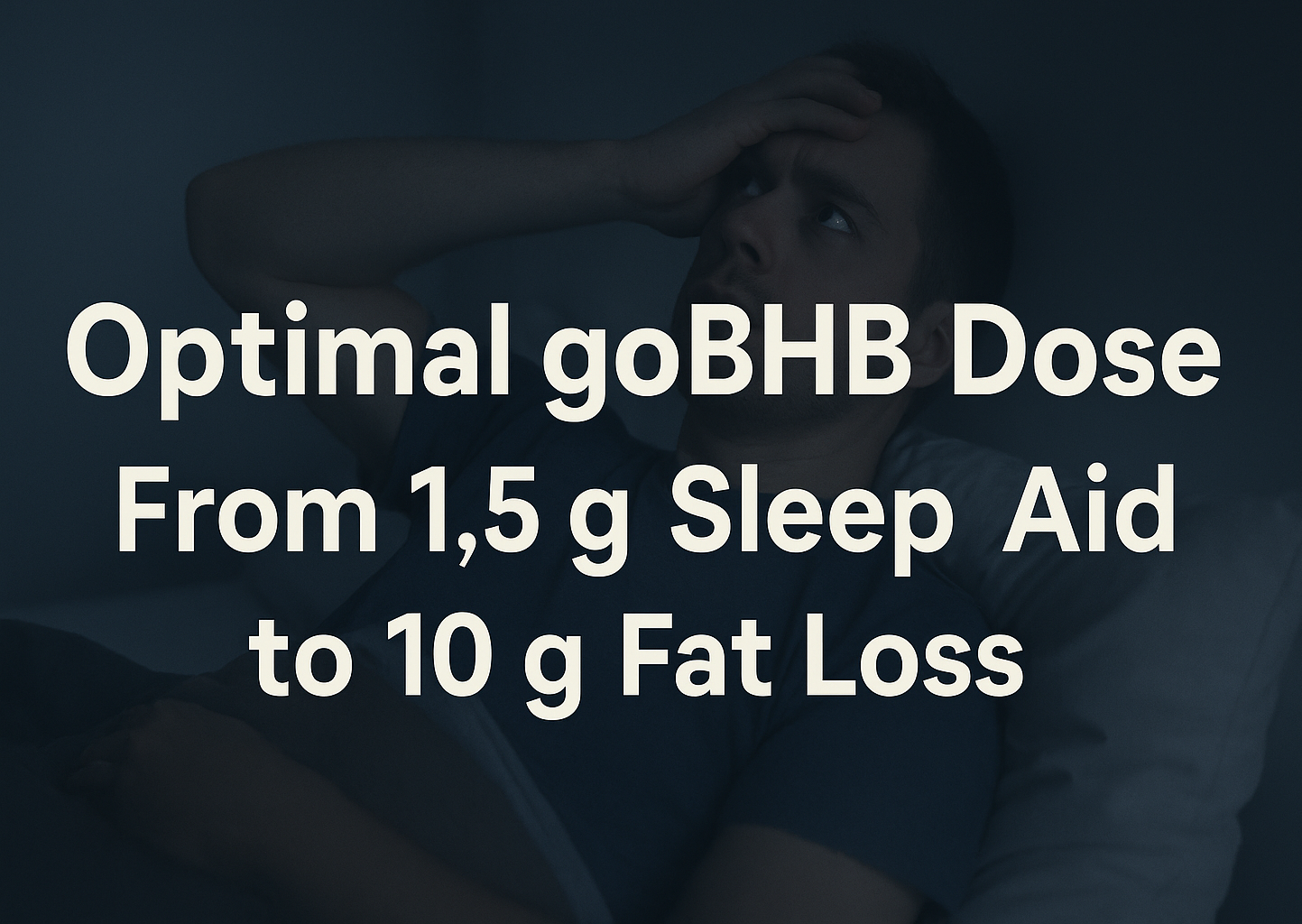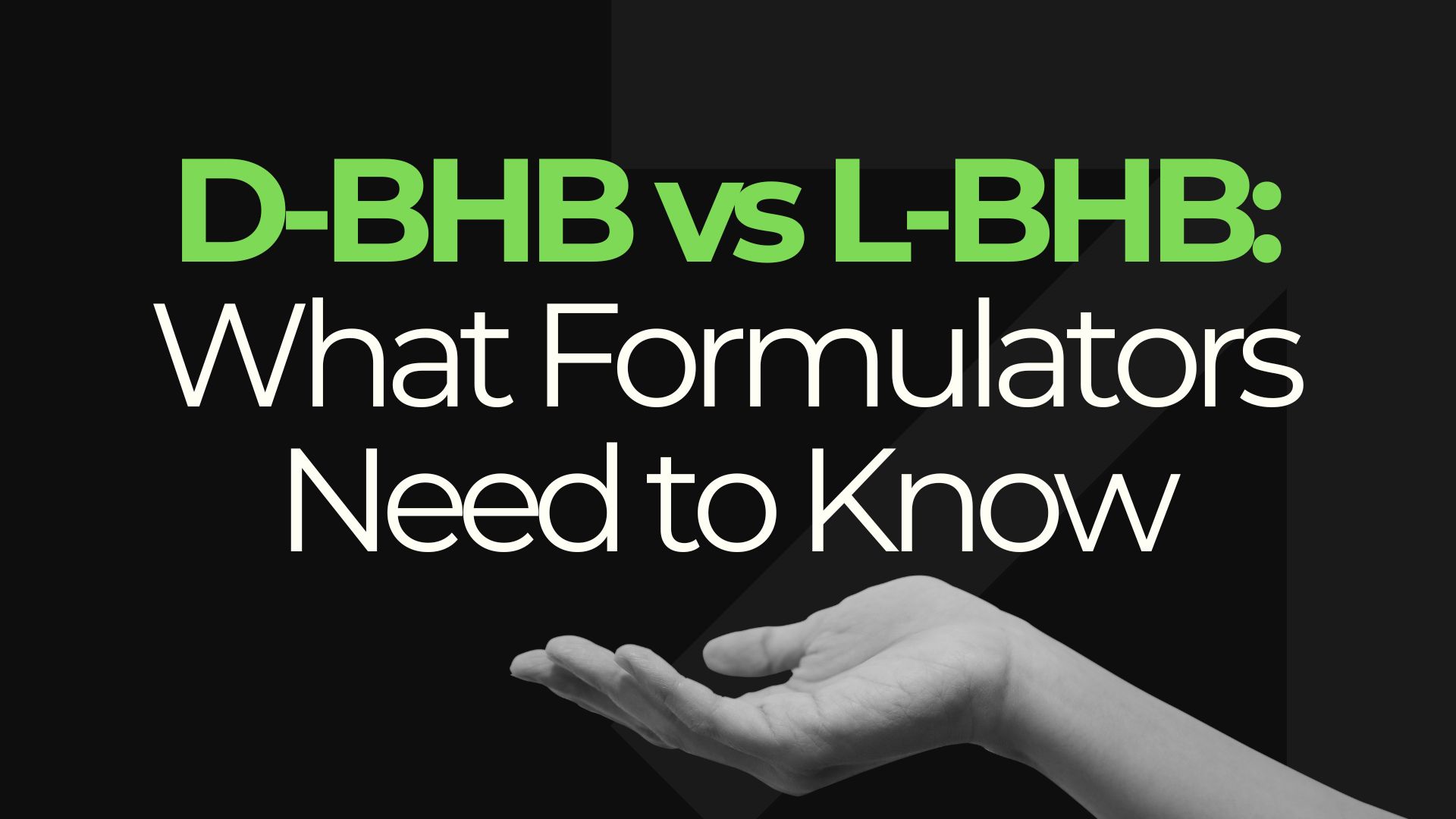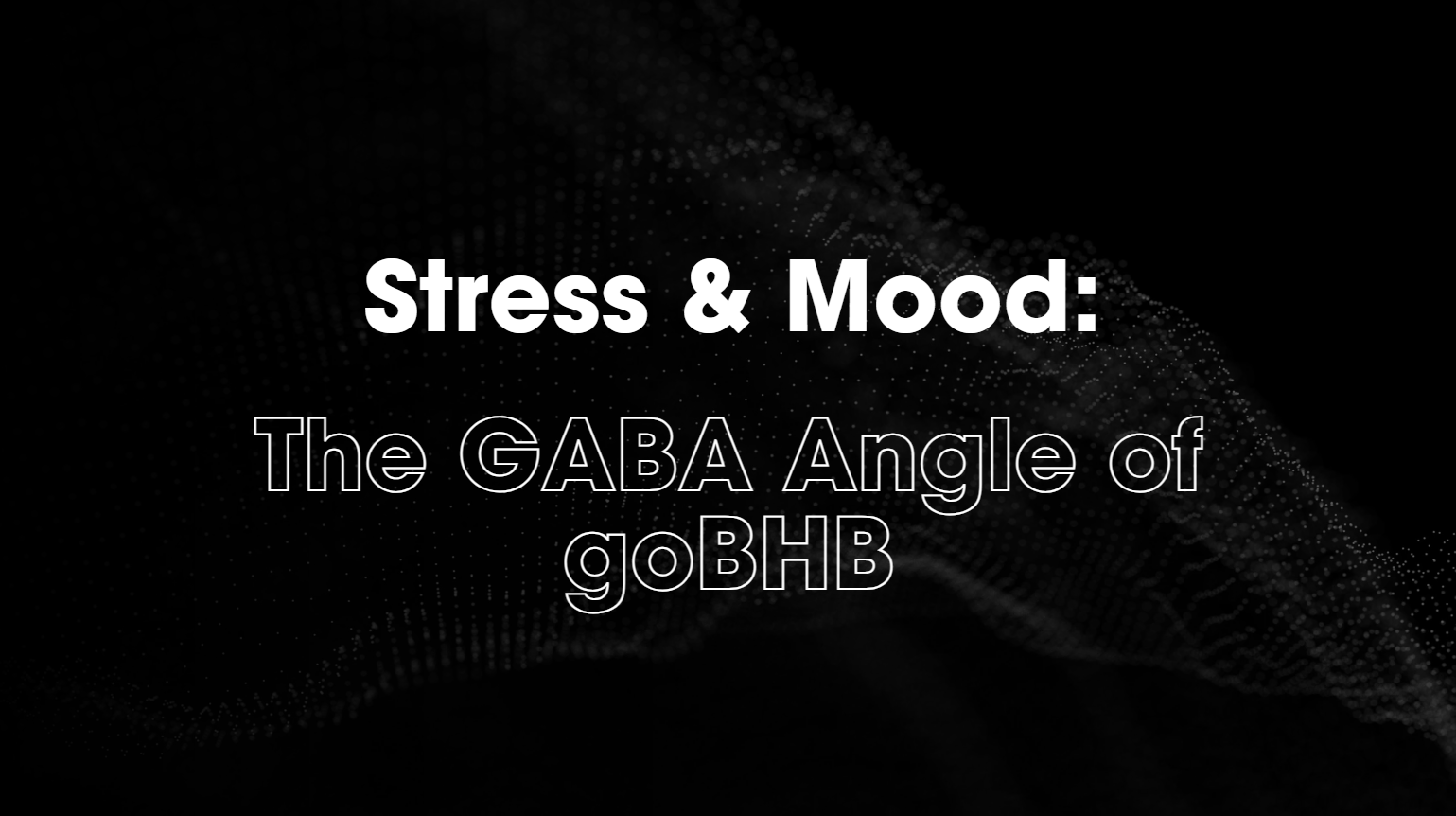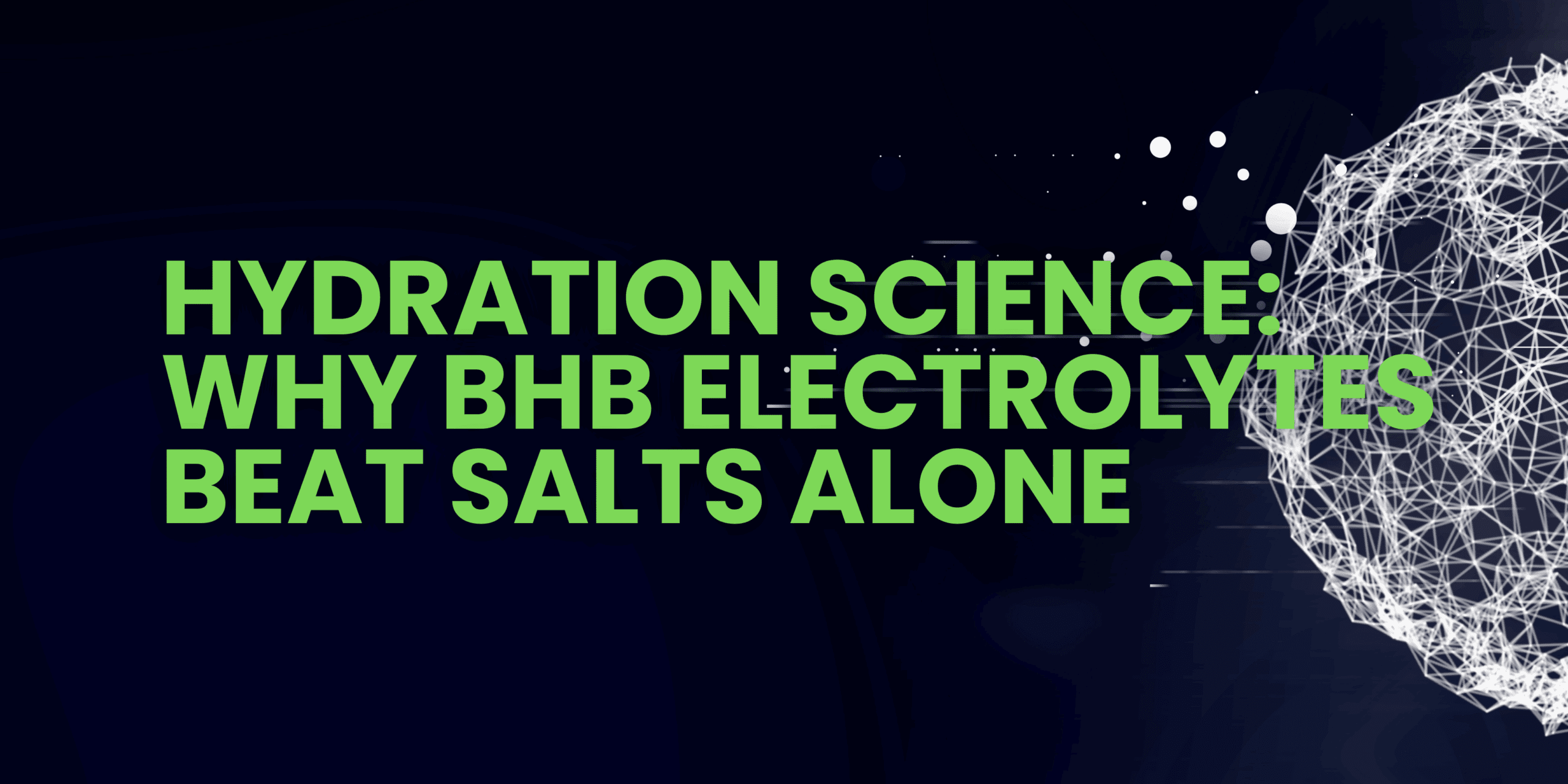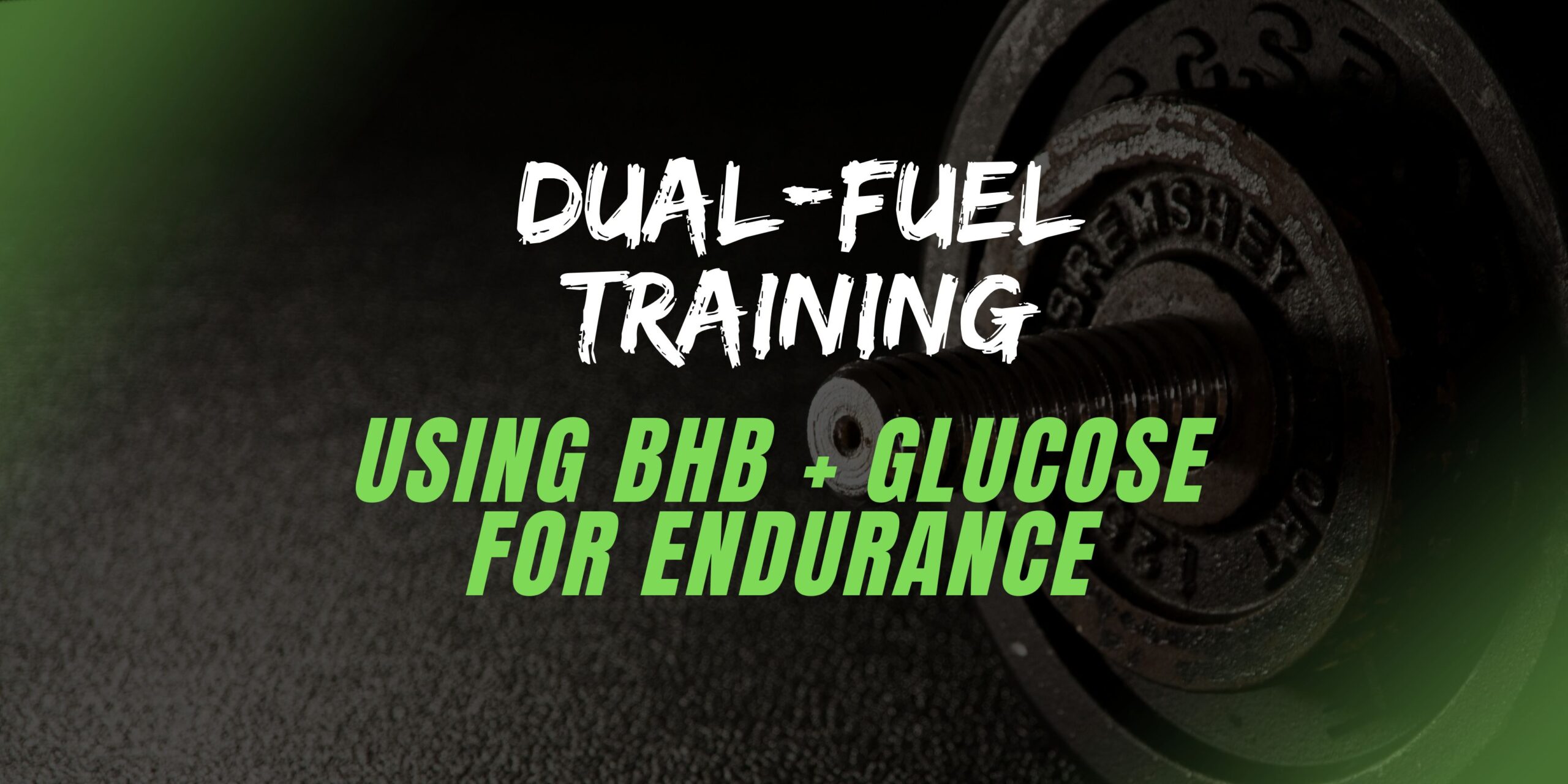Fueling the Injured Brain: How GoBHB Supports Concussion Recovery
After a concussion, the brain struggles to use glucose—the body’s primary fuel—triggering an energy crisis that delays recovery. GoBHB™, a patented form of beta-hydroxybutyrate (BHB), offers a clean alternative fuel that crosses the blood-brain barrier, restores mitochondrial function, reduces oxidative stress, calms inflammation, and promotes neuroplasticity.
In this talk, metabolic scientist Dr. Benjamin Bikman explains how high-dose GoBHB can empower the concussed brain immediately after impact, support long-term cognitive health, and even help athletes precondition their brains before high-risk games. Discover why BHB is one of the most promising tools for protecting and repairing the brain after trauma.
Protecting Young Athletes’ Brains: The Role of BHB in Concussion Prevention and Recovery
A concussion is not just an injury—it’s a metabolic crisis. After a head impact, the brain suddenly loses its ability to use glucose efficiently, leaving neurons starved for energy. Beta-hydroxybutyrate (BHB), a natural alternative fuel, can bypass this glucose bottleneck, restore energy flow, reduce oxidative stress, calm inflammation, and support neuronal repair.
In this video, metabolic scientist Dr. Benjamin Bikman explains how GoBHB™, a patented form of BHB, can precondition the brain before a game and accelerate recovery after a concussion. From youth football to professional sports, raising BHB levels gives athletes an added layer of resilience—helping them think clearer, recover faster, and protect long-term brain health.
goBHB and Concussions: The Biggest Breakthrough in Athlete Safety
BHB for Performance: How goBHB Improves Heart Function, Energy, and Endurance
Optimal goBHB Dose: From 1.5 g Sleep Aid to 10 g Fat Loss
When incorporating Beta-Hydroxybutyrate (goBHB) into dietary supplements, the most common query from consumers is, “How much goBHB should I take?” Understanding optimal dosages based on specific health outcomes—from enhancing sleep quality to supporting fat loss—is critical for effective product use and consumer satisfaction.
This detailed guide outlines evidence-based goBHB dosages, connecting specific gram amounts to desired benefits, helping consumers and formulators make precise and informed decisions.
goBHB: The Science-Backed Ketone
goBHB, a patented exogenous ketone, is clinically proven to enhance cellular energy, metabolic function, cognitive performance, and overall wellness. Unlike stimulants such as caffeine, goBHB offers clean, sustainable energy without crashes.
Why Dosage Matters
Dosage precision is critical with goBHB because benefits vary significantly with quantity:
- Lower doses (1-3 grams) address cognitive support and sleep.
- Moderate doses (4-8 grams) target cognitive enhancement, mood stabilization, and reaction time improvements.
- Higher doses (10 grams) focus on significant metabolic changes, fat loss, and cholesterol improvement.
Sleep Improvement: 1.5 grams goBHB
Recommended Dose:
- 1.5 grams daily
Clinical Insights:
- Clinical studies confirm that low-dose goBHB (1.5 g) effectively enhances sleep quality, promoting deeper, restorative sleep without sedative effects.
- Ideal for nighttime formulations, sleep aids, or supplements aimed at general wellness with subtle cognitive benefits.
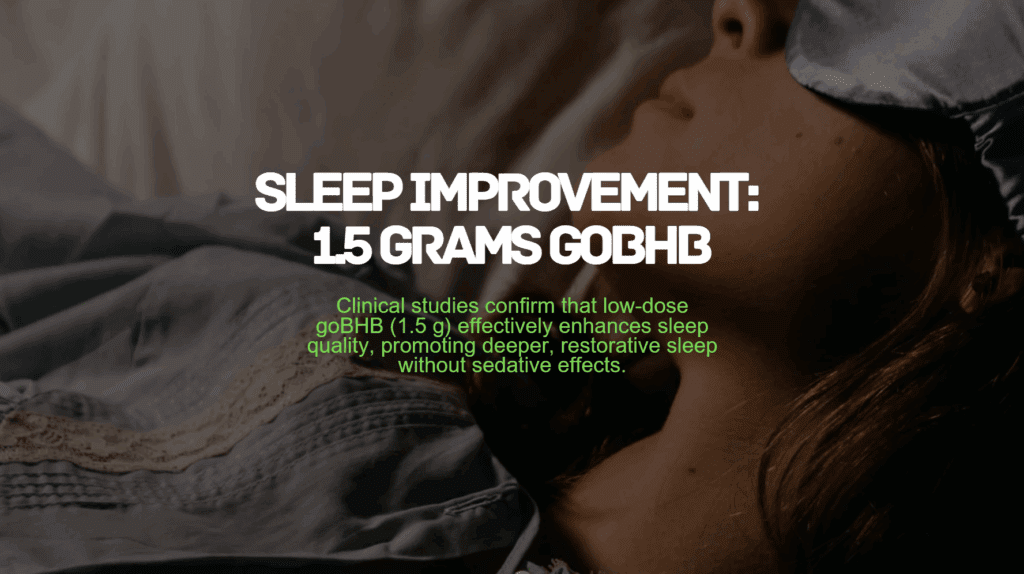
Cognitive Enhancement & Stress Reduction: 2-8 grams goBHB
Recommended Dose Range:
- 2 to 8 grams daily, often combined with Medium Chain Triglycerides (MCT)
Clinical Insights:
- At doses between 2-8 grams, goBHB effectively enhances brain speed, cognitive clarity, and mood stabilization.
- A combination of 8 grams goBHB and 2 grams MCT demonstrated a 39% reduction in anxiety symptoms, making it ideal for stress-relief supplements.
- Excellent for formulations targeting mental performance, gamers, professionals, or mood support products.
Fat Loss and Metabolic Health: 10 grams goBHB
Recommended Dose:
- 10 grams daily
Clinical Insights:
- Clinically validated by the Center for Applied Health Sciences, a 10-gram daily dose significantly improves metabolic markers:
- Fat loss: Enhances fat metabolism, promoting measurable decreases in fat mass.
- Cholesterol and LDL Reduction: Proven reduction in total and LDL cholesterol, supporting cardiovascular health.
- Insulin Sensitivity: Enhanced insulin regulation, supporting metabolic wellness.
- Best suited for weight management supplements, metabolic enhancers, and comprehensive wellness products targeting cardio-metabolic health.
Athletic Performance and Recovery: 6-10 grams goBHB
Recommended Dose Range:
- 6 to 10 grams daily
Clinical Insights:
- goBHB in this range significantly enhances endurance, energy sustainability, and reduces post-exercise fatigue.
- Optimal for pre-workout, intra-workout, or recovery products aimed at athletes and fitness enthusiasts.
Dose Customization for Formulators
Formulators aiming to leverage goBHB’s flexibility should:
- Clearly define the target audience (athletes, cognitive enhancement seekers, weight management consumers).
- Adjust dosages within clinically validated ranges for targeted effectiveness.
- Ensure accurate labeling to enhance consumer trust and compliance.
Key Recommendations for Consumers
- Always follow labeled instructions for the intended health benefit.
- Begin with lower dosages to gauge tolerance before scaling to higher, clinically proven dosages.
- Consult health professionals when combining goBHB with other supplements or medications.
Conclusion: Tailoring Your goBHB Experience
Whether improving sleep at 1.5 grams, enhancing cognitive performance between 2-8 grams, or optimizing metabolic health at 10 grams, goBHB offers powerful, dose-specific benefits. Correctly calibrated doses lead to predictable, impressive outcomes, enhancing both consumer satisfaction and product efficacy.
These statements have not been evaluated by the FDA.
D-BHB vs L-BHB: What Formulators Need to Know
The surge in popularity of Beta-Hydroxybutyrate (BHB) supplements, particularly for energy, cognitive enhancement, and metabolic health, has brought attention to the critical distinction between its two stereoisomers: D-BHB and L-BHB. For formulators and R&D professionals, understanding these differences is essential to creating optimal products for health, wellness, and performance.
Isomer Overview: D-BHB and L-BHB
BHB exists naturally in two distinct forms (stereoisomers): D-BHB (the “right-handed” form) and L-BHB (the “left-handed” form). Despite similar molecular structures, these isomers exhibit significant differences in bioavailability, metabolic pathways, and physiological effects.
Metabolic Pathways and Bioavailability
D-BHB (Natural Isomer)
- D-BHB is the naturally occurring form produced in the liver from fatty acid breakdown during ketosis.
- It is directly metabolized by mitochondria into ATP (adenosine triphosphate), serving as a potent, immediate source of energy.
- Blood ketone meters measure exclusively D-BHB due to its primary role in human metabolism.
L-BHB (Emerging Focus)
- L-BHB is less abundant naturally and previously considered metabolically inactive. Recent research has revised this view, highlighting its unique physiological roles.
- L-BHB acts prominently as a signaling molecule, affecting gene expression, neuronal activation, and promoting neuroprotection.
- While initially underestimated, L-BHB has demonstrated the ability to fully metabolize into bioavailable energy, revealing untapped therapeutic potentials.
Physiological and Clinical Differences
Energy Efficiency and ATP Yield
- D-BHB: Demonstrates exceptional efficiency in ATP production, offering approximately 2.5 times more energy per unit carbon compared to glucose, significantly beneficial for sports nutrition and metabolic health.
- L-BHB: Historically overlooked in ATP production, recent evidence shows L-BHB contributes to significant ATP yields over extended periods, with a distinct metabolic profile compared to its counterpart.
Neurological and Cognitive Effects
- D-BHB: Rapidly crosses the blood-brain barrier, enhancing cognitive function and reducing neural fatigue by directly providing neurons with efficient energy.
- L-BHB: Has pronounced effects as a neuronal activator and signaling molecule, stimulating specific pathways associated with improved cognitive performance, neuroprotection, and stress reduction.

Clinical Application and Safety
- Both D-BHB and L-BHB demonstrate excellent safety profiles, yet their distinct metabolic roles make them suitable for different therapeutic and supplement applications.
- D-BHB: Ideal for immediate energy supplementation, weight management, improved athletic performance, and supporting metabolic health.
- L-BHB: Potential applications in cognitive support, stress reduction, mood enhancement, and promoting “flow state” due to its neuroactive properties.
Synergistic Potential: D/L-BHB Combination
Emerging studies suggest that combining both isomers in precise ratios maximizes their complementary benefits, enhancing overall physiological effectiveness:
- Balanced isomer formulations might leverage D-BHB’s superior energy provision with L-BHB’s neurological and signaling advantages.
- Research in rare genetic conditions such as Multiple Acyl-CoA Dehydrogenase Deficiency (MADD) underscores the necessity of both isomers, confirming the synergistic effects.
Practical Formulation Insights
Formulators should consider:
- Energy-focused Products: Prioritize D-BHB dominance.
- Cognitive and Mood-focused Supplements: Incorporate higher ratios of L-BHB to capitalize on its neuroactive properties.
- Hybrid Formulations: Offer a balanced blend to harness both metabolic energy and cognitive enhancement, appealing to broad-spectrum wellness markets.
Future Research Directions
Continuing investigations are exploring optimal D/L-BHB ratios, formulation stability, and bioavailability enhancement techniques. Formulators and researchers should remain abreast of emerging studies to leverage these findings for next-generation supplement innovation.
Conclusion
Understanding the nuanced distinctions between D-BHB and L-BHB enables formulators to tailor supplements precisely to targeted health outcomes. Leveraging the complementary strengths of these isomers represents a significant opportunity for product differentiation and efficacy enhancement.
These statements have not been evaluated by the FDA.
Stress & Mood: The GABA Angle of goBHB
Modern lifestyles increasingly drive people toward chronic stress and anxiety. According to the American Psychological Association, approximately 84% of adults recently reported experiencing prolonged stress, with 54% noting stress levels increasing year-over-year. This rising need for effective stress relief has spotlighted Beta-Hydroxybutyrate (BHB), particularly its role in influencing Gamma-Aminobutyric Acid (GABA), a neurotransmitter pivotal to stress and mood regulation.
Understanding Stress, Anxiety, and GABA
Stress and anxiety responses are heavily mediated by neurotransmitters—chemical messengers within the brain. GABA, the chief inhibitory neurotransmitter, helps maintain balance by calming excessive neural activity. Reduced GABA levels are linked to heightened anxiety, emotional instability, and poor stress resilience.
How goBHB Influences GABA and Stress Reduction
Enhanced GABA Production
- BHB supplementation indirectly promotes GABA production by optimizing neuronal energy supply, facilitating balanced neurotransmitter release.
- Improved GABA signaling effectively dampens neuronal excitability, alleviating anxiety and fostering calmness.
Reduced Oxidative Stress
- goBHB produces significantly fewer Reactive Oxygen Species (ROS)—up to 46 times less than glucose metabolism.
- Lower oxidative stress positively influences neural health, supporting more efficient GABA functioning and overall stress resilience.
Clinical Evidence of goBHB’s Anxiety Reduction
- A notable clinical study found that combining goBHB with Medium Chain Triglycerides (MCT) reduced stress and anxiety by 39% among participants. This highlights goBHB’s substantial potential in managing common stress-related disorders.
Cognitive and Emotional Benefits
- Improved Cognitive Clarity: goBHB crosses the blood-brain barrier effortlessly, enhancing cognitive function, reducing mental fatigue, and improving emotional stability.
- Mood Regulation: By promoting optimal GABA levels, goBHB stabilizes mood, reducing the frequency and intensity of stress responses, and promoting overall emotional well-being.
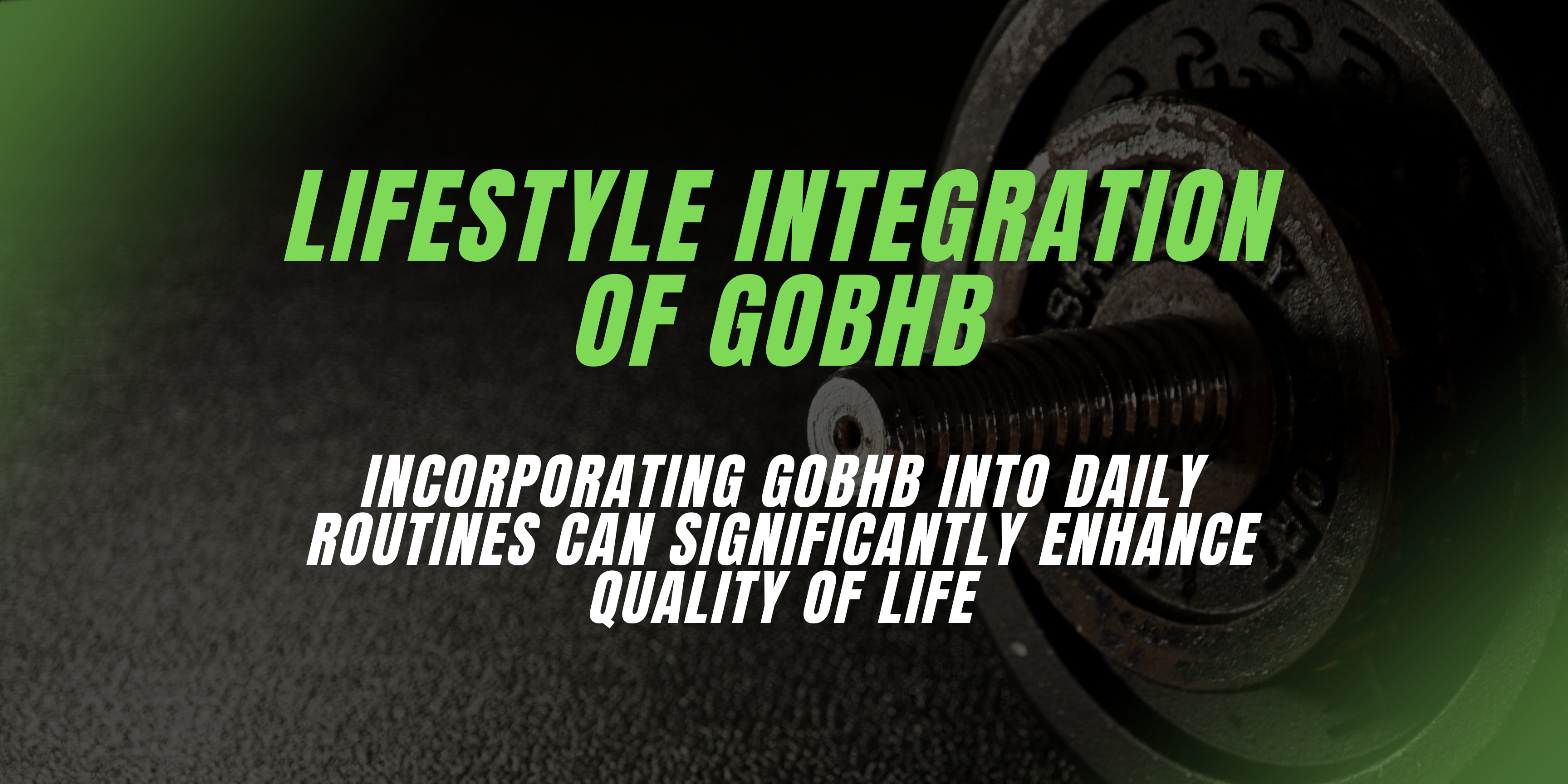
Lifestyle Integration of goBHB
Incorporating goBHB into daily routines can significantly enhance quality of life:
- Workplace Resilience: Supports sustained cognitive performance and stress management in demanding professional environments.
- Athletic Performance: Enhances recovery and reduces mental stress during training and competitive events.
- Daily Emotional Balance: Regular supplementation promotes long-term emotional stability, essential for handling day-to-day stressors.
Future Directions in Stress Relief
Ongoing research continues to explore how goBHB can synergize with other nutrients or adaptogens to further optimize stress and anxiety reduction, providing personalized solutions for diverse populations, including those with chronic stress or anxiety disorders.
Conclusion
With stress and anxiety escalating globally, goBHB emerges as an essential component in promoting mental calmness and emotional stability. By positively influencing GABA production and reducing oxidative stress, goBHB provides an innovative, scientifically validated pathway to enhance mood, reduce anxiety, and foster lasting stress resilience.
These statements have not been evaluated by the FDA.
Hydration Science: Why BHB Electrolytes Beat Salts Alone
Optimal hydration is fundamental for athletic performance, cognitive clarity, and overall metabolic health. While traditional electrolyte drinks replenish basic minerals, the latest science underscores why Beta-Hydroxybutyrate (BHB) electrolytes significantly outperform conventional salts alone.
Understanding Hydration and Electrolyte Balance
Proper hydration involves more than just drinking water. Electrolytes such as sodium, potassium, calcium, and magnesium regulate fluid balance, nerve signaling, and muscle function. The American Heart Association suggests adults consume no more than 2,300 mg of sodium daily, while ideal potassium intake stands at 2,600 mg for women and 3,400 mg for men.
Yet, maintaining electrolyte balance through salts alone provides only baseline hydration.
BHB Electrolytes: A New Frontier in Hydration
Beta-Hydroxybutyrate (BHB) electrolytes represent an advanced category of hydration support, combining essential electrolytes with the potent metabolic benefits of ketones. Unlike traditional electrolytes, BHB electrolytes directly impact cellular hydration through osmoregulation and metabolic energy pathways.
How BHB Electrolytes Enhance Cellular Hydration
Superior Energy Efficiency
- BHB generates approximately 225% more energy per molecule than glucose, translating into improved cellular performance.
- Cells utilizing BHB experience enhanced metabolic efficiency, producing more ATP per oxygen unit consumed, vital for sustained hydration and energy balance.
Reduced Oxidative Stress
- Metabolism of BHB creates significantly fewer Reactive Oxygen Species (ROS)—up to 46 times less than glucose metabolism—helping protect cells from oxidative stress and inflammation.
- This cleaner metabolic pathway supports healthier cells, crucial for maintaining long-term hydration status and cellular integrity.
Osmoregulation and Fluid Balance
- BHB electrolytes assist in maintaining fluid balance at a cellular level, ensuring hydration reaches critical systems like muscles and the brain more effectively.
- By stabilizing electrolyte ratios within the body, BHB electrolytes mitigate dehydration risks associated with intense physical activity or heat exposure.
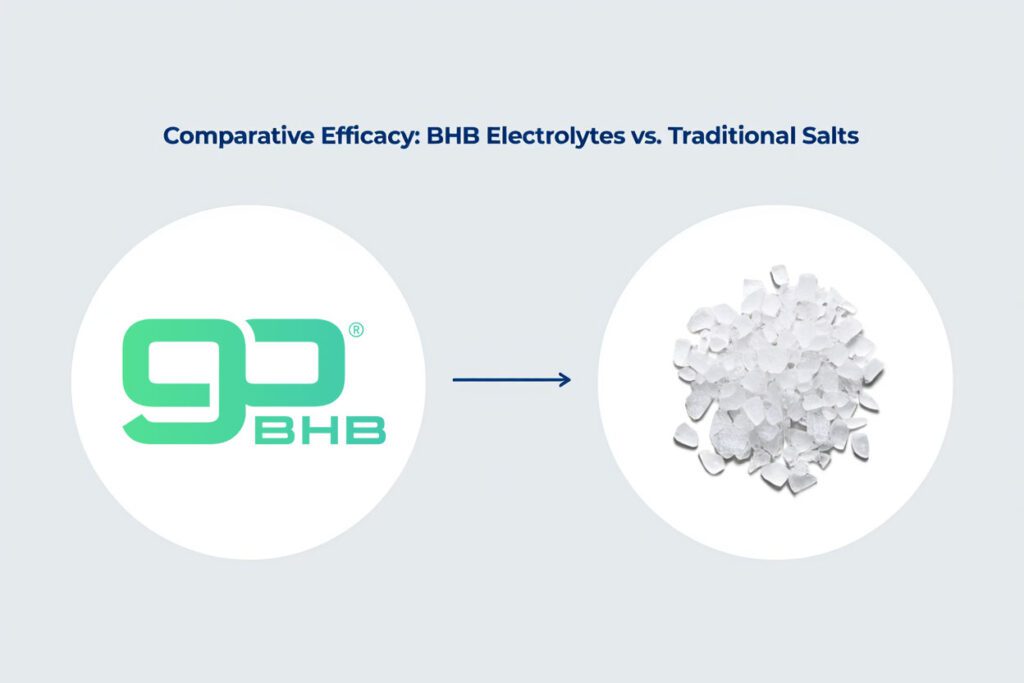
Comparative Efficacy: BHB Electrolytes vs. Traditional Salts
Scientific evaluations consistently demonstrate superior hydration markers and performance outcomes when using BHB electrolytes compared to conventional salts alone. Athletes using BHB electrolytes report improved endurance, reduced recovery times, and enhanced cognitive function.
Benefits Beyond Hydration
- Enhanced Athletic Performance: BHB electrolytes support sustained energy release and muscle recovery, boosting endurance and reducing fatigue.
- Metabolic Health Improvement: Regular supplementation with BHB electrolytes has shown significant metabolic health improvements, including better blood sugar control, insulin sensitivity, and body composition management.
- Cognitive Advantages: The brain readily uses BHB as fuel, promoting greater mental clarity, focus, and reduced mental fatigue—critical during periods of high physical and cognitive demand.
Applications and Future Directions
Research continues to explore the optimization of BHB electrolyte formulations for targeted populations, such as elderly individuals or those managing chronic conditions requiring advanced hydration strategies. Investigations into synergistic effects of BHB electrolytes combined with other nutritional supplements hold promise for even broader application.
Conclusion
BHB electrolytes mark a significant advancement in hydration science, providing superior hydration and metabolic advantages over traditional salts alone. Leveraging these innovative electrolyte solutions can redefine performance, recovery, and overall wellness.
These statements have not been evaluated by the FDA.
Dual-Fuel Training: Using BHB + Glucose for Endurance
How to Optimize Endurance with BHB + Glucose
For athletes and fitness enthusiasts seeking peak endurance performance, the concept of dual-fuel workout strategies—using both BHB (beta-hydroxybutyrate) and glucose—is rapidly gaining traction. This comprehensive guide breaks down how to implement dual-fuel training with goBHB® and glucose, grounded in science and applicable to real-world training.
What Is Dual-Fuel Training?
Dual-fuel training involves leveraging two distinct energy substrates:
- Glucose (Carbohydrate): Provides immediate, high-intensity fuel via glycolysis.
- BHB (Ketone Body): Offers sustained, oxidative fuel with higher ATP yield and lower oxidative stress.
This method mirrors the Dual Fuel Performance Stack approach, optimizing both rapid energy and long-term endurance
by combining the best attributes of carbohydrates and ketones.
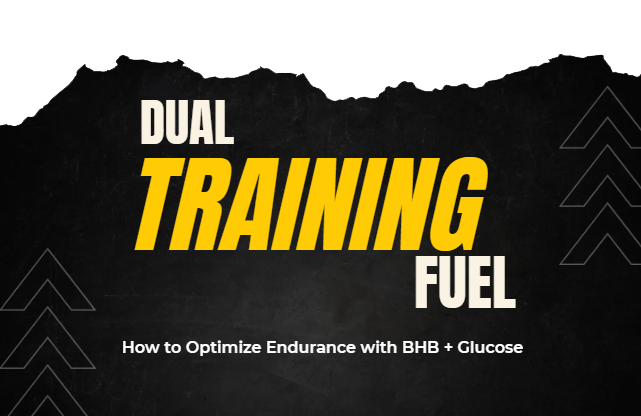
Why Combine BHB + Glucose?
Physiologically, the body naturally toggles between glucose and fat-derived fuels. However, high-intensity efforts rely heavily
on glycogen (stored glucose), which depletes quickly. BHB supplementation fills the gap by supplying:
- Sustained Cellular Energy: BHB provides ATP with approximately 225% more efficiency per oxygen unit compared to glucose.
- Reduced Fatigue: BHB minimizes lactate buildup, preserving muscle function.
- Extended Endurance: Dual-fuel systems improve time-to-exhaustion and recovery.
Scientific Basis for Dual-Fuel Workout Strategies
Multiple studies support dual-fuel approaches:
- Metabolic Flexibility Research (Pinckaers et al., 2017): Combining carbs and exogenous ketones (like BHB) improved endurance performance compared to carbs alone.
- Ketone Supplementation Studies (Cox et al., 2016): Demonstrated increased endurance, reduced glycogen depletion, and enhanced recovery in trained athletes.
The goBHB Dual Fuel Performance Stack builds on these findings, providing a standardized protocol for sports nutrition applications.
How to Implement Dual-Fuel Training: Step-by-Step
Step 1: Pre-Workout Dual-Fuel Loading
Goal: Maximize glycogen stores while priming the body with ketones.
- Timing: 30–45 minutes before workout.
- Protocol:
- goBHB: 10–12 grams (standard dose for most athletes).
- Glucose Source: 20–30 grams from fast-absorbing carbohydrates (e.g., dextrose, glucose gels).
- goBHB: 10–12 grams (standard dose for most athletes).
- Why: Elevates both blood glucose and ketone levels, ensuring both rapid and sustained energy availability.
Step 2: Intra-Workout Dual-Fuel Maintenance
Goal: Maintain consistent energy levels, prevent glycogen depletion.
- Timing: Every 30–60 minutes during prolonged sessions (90+ minutes).
- Protocol:
- goBHB: 5–8 grams in diluted beverage (mixed with electrolytes).
- Glucose Source: 10–15 grams as isotonic sports drink.
- goBHB: 5–8 grams in diluted beverage (mixed with electrolytes).
- Why: Sustains dual-fuel availability, buffers fatigue-related declines in performance.
Step 3: Post-Workout Recovery Optimization
Goal: Replenish glycogen and support recovery via ketone-driven mitochondrial repair.
- Timing: Within 30 minutes post-exercise.
- Protocol:
- goBHB: 10 grams.
- Glucose Source: 30–40 grams.
- goBHB: 10 grams.
- Why: BHB aids in muscle recovery, reduces oxidative stress, while glucose restores glycogen stores.
Example Dual-Fuel Workout Plan
| Phase | Time Before/During/After | goBHB Dose | Glucose Dose |
| Pre-Workout | 30–45 minutes prior | 10–12 g | 20–30 g |
| Intra-Workout | Every 45–60 minutes | 5–8 g | 10–15 g |
| Post-Workout | Within 30 minutes | 10 g | 30–40 g |
Real-World Use Cases
Endurance Running
- Scenario: Marathon training session (2.5–3 hours).
- Protocol: Pre-load with 12 g goBHB + 30 g glucose. Sip 5 g goBHB + 12 g glucose every 45 minutes during the run. Post-run recovery with 10 g goBHB + 35 g glucose.
Cycling
- Scenario: Long-distance ride (4+ hours).
- Protocol: Pre-load with 15 g goBHB + 40 g glucose. Maintain intra-ride fueling with 6–8 g goBHB + 15 g glucose every 30–45 minutes. Post-ride recovery same as above.
CrossFit/HIIT
- Scenario: Intense 60-minute session.
- Protocol: Pre-load only, as sessions are shorter. 10–12 g goBHB + 20–25 g glucose 30 minutes before the workout.
Key Advantages of goBHB in Dual-Fuel Training
- Sustained Energy Without Crash: Unlike glucose-only fueling, goBHB prevents sharp blood sugar fluctuations.
- Reduced Lactate Accumulation: Enhances aerobic capacity by mitigating lactate buildup.
- Improved Recovery: BHB accelerates mitochondrial repair and reduces oxidative stress post-exercise.
Potential Challenges and Considerations
- Dosing Precision: Tailoring goBHB and glucose amounts based on body weight and workout intensity is essential.
- Gastrointestinal Tolerance: Start with lower doses of goBHB to assess tolerance, particularly for intra-workout use.
- Personalization: Athletes with different metabolic profiles may require adjusted ratios—monitor performance and adjust accordingly.
Future Directions in Dual-Fuel Research
Emerging research areas include:
- Optimizing BHB-to-Glucose Ratios: Determining the ideal balance for different sports.
- Impact on Mitochondrial Biogenesis: Investigating long-term adaptations from consistent dual-fuel training.
- Applications in Team Sports: Expanding beyond endurance into mixed-energy demand activities like soccer or basketball.
Why Dual-Fuel Training with goBHB + Glucose Works
By combining glucose’s fast energy with goBHB’s sustained, efficient fuel, dual-fuel workout strategies provide a scientifically validated method for maximizing endurance performance. This method is particularly effective for:
- Marathon runners.
- Long-distance cyclists.
- High-intensity interval training (HIIT) enthusiasts.
- Any athlete seeking optimal performance and rapid recovery.
Implementing goBHB as part of a dual-fuel training regimen isn’t just about more energy—it’s about smarter, cleaner, and longer-lasting performance support.
Disclaimer: These statements have not been evaluated by the FDA. This product is not intended to diagnose, treat, cure, or prevent any disease.






